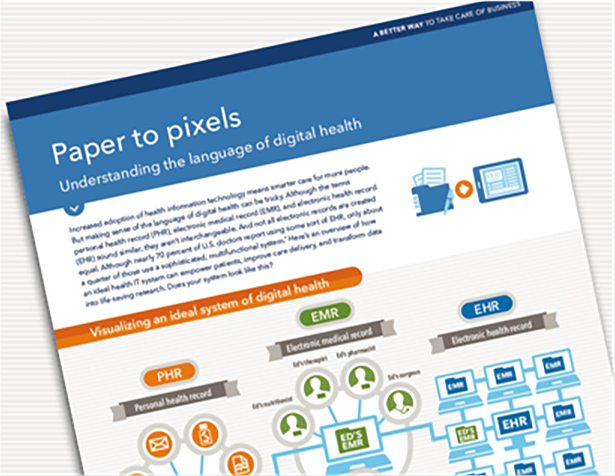Explaining the Value of Digital Health
May 22, 2015
This is the first in a series of articles about digital health. Be sure to also check out A Look at True Connectivity in Health Care.
These days there’s a lot of talk about the power of electronic medical records (EMRs) to transform care. But EMRs are just one element in a bigger digital health environment. While nearly 70% of U.S. doctors say they use some form of EMR, only 25% of them use sophisticated electronic health record (EHR) systems that can send preventive care reminders or electronic prescriptions.*
Digital health technology is groundbreaking, but it has a limited impact if caregivers aren’t connected to the same electronic health record system. This can lead to care fragmentation external link — where individual care decisions are made without taking into account the patient’s full picture of health — which can increase errors, missed diagnoses, and medical costs. Plus, patients might not be able to do things like email their doctor, check lab results, and order prescriptions online. In fact, 90% of Americans have never emailed their doctors.†

Paper to Pixels Infographic
Download this infographic to learn how an ideal electronic health record system can connect caregivers, hospitals, and patients to transform care — and empower employees to manage their health. You’ll see:
- how medical records have evolved over time
- the difference between EMRs, EHRs, and personal health records
- questions to help you evaluate the care your employees are getting now
A glossary of digital health terms
- Digital health — an umbrella term that encompasses health-related applications and technologies such as telemedicine, mobile health, electronic health records, wellness apps, and wearables
- Electronic health record (EHR) — a secure electronic database that houses information from all available patient medical records
- Electronic medical record (EMR) — a patient’s digital medical chart that doctors and other caregivers can refer to; includes medical history, MRIs, X-rays, allergies, test results, and more
- Personal health record (PHR) — a secure portal through which patients can access some of their electronic medical record information, as well as schedule appointments, check lab results, order prescriptions, and modify personal information




